The HTC 10 Review
by Joshua Ho on September 19, 2016 8:00 AM ESTCamera Architecture and UX
The camera of the HTC 10 is one of the most important aspects to examine. While the HTC One M7 was a big leap forward for HTC, in the years since we’ve seen a general stagnation on HTC’s part. The One M8 was effectively identical to the One M7 for the rear camera other than the addition of a depth-sensing camera and the deletion of OIS. The One M9 shipped with a camera that was a disappointment at best due to a lack of OIS and extremely poor image processing algorithms. The lack fast auto-focus mechanisms like phase-detect AF and rangefinder-guided contrast AF also significantly impacted the user experience, as did the long focus and capture times. While there were a lot of problems with the One M9, the poor camera was one major dealbreaker. Even if RAW output could be respectable, it’s impossible to recommend a phone when you have to boot up a laptop to process an image any time you want something to share on social media.
While HTC could continue to ship mediocre cameras, it’s probably not a far leap to say that doing so would make them irrelevant in the high-end smartphone market when devices like the Nexus 5X, OnePlus 3, and iPhone SE are all shipping pretty great cameras for less than 400 USD. To figure out whether the HTC 10’s camera is competitive, we can start by looking at the basic specs of the camera before diving deeper.
| HTC Flagship Cameras | ||||
| HTC One M9 | HTC 10 | |||
| Front Camera | 4MP | 5.0MP | ||
| Front Camera - Sensor | Omnivision OV4688 (2 µm, 1/3") |
Samsung S5K4E6 (1.34 µm, 1/4") |
||
| Front Camera - Focal Length | 3.82mm (26.8mm eff) | 2.34mm (23mm eff) | ||
| Front Camera - Max Aperture | F/2.0 | F/1.8 | ||
| Rear Camera | 20MP | 12MP | ||
| Rear Camera - Sensor | Toshiba T4KA7 (1.12 µm, 1/2.4") |
Sony IMX377 (1.55 µm, 1/2.3") |
||
| Rear Camera - Focal Length | 4.73mm (27.8mm eff) | 4.58mm (26mm eff) | ||
| Rear Camera - Max Aperture | F/2.2 | F/1.8 | ||
At a high level, it seems that HTC has learned a lot from their previous cameras in a lot of ways by integrating a high-quality sensor, as well as a laser auto-focus module. The IMX377 isn’t necessarily anything new, but HTC’s use of a wide aperture distinguishes it from other devices using the same sensor. Really, the only notable point of concern here is the 26mm equivalent focal length which makes for a very wide field of view. While this may sound like a good thing to have, generally speaking it seems that reducing focal length is generally done to reduce the thickness of the optics stack. Combined with the wide aperture I suspect that this may affect overall performance. The HTC 10 already has a noticeable camera hump so I suspect that increasing this hump to improve optical performance wouldn’t be that noticeable.
Overall, the architecture of the camera on the HTC 10 isn’t necessarily exotic, but it’s starting at a good place. The large sensor, pixel size, and wide aperture along with OIS should mean good things for low light sensitivity and laser AF should make for fast focusing if done right. The improved ISP in the Snapdragon 820 should also help with image processing quality, but this is conditional on whether HTC has done their part. I should also mention that the front-facing camera is automatically one of the best I’ve ever seen on the basis of having an actual VCM and OIS which allows for the camera to actually focus on a subject rather than focusing at infinity.
Before we get into image quality though I want to discuss the user experience that comes with using the camera on the HTC 10. The easiest place to start is the camera application itself, which launches quickly. However, the gesture to launch the camera application is swiping downwards twice on the display. This gesture works, but it’s honestly fairly slow and I suspect that a double press of a volume button with the screen off would be a much faster gesture. Other than this issue though, the camera app launches fast enough that the latency doesn’t stick out as a sore point.
Getting into the camera app itself, the UI has been significantly updated relative to previous devices. While the UI is going to be immediately familiar and easy to use for pretty much anyone, it retains a clean look that is generally not seen in Android devices. Following with navigation conventions for Android, rather than placing an overflow button in the UI there is just a slide-out drawer for all of the settings and camera modes which is simple and clean. The only real complaint I have here is that pressing the back button will exit the camera app entirely rather than close the overflow drawer, which is somewhat unnatural.
The extra camera modes are also generally implemented sensibly, but from a UX perspective the Zoe camera mode is not the best as Google’s photo gallery application doesn’t integrate the 720p video and photo into a single “photo” as seen in previous implementations of Zoe with HTC Gallery, and similar features on other devices. Pro mode continues to be included and while the ability to change all sliders all at once is kind of interesting to have, practically speaking it really just makes it easy to clutter the screen with a bunch of sliders. I’m not totally sold on the design of the Pro camera mode, but this is mostly a minor complaint so I wouldn’t put too much emphasis here.
Other than some minor usability issues I honestly didn’t find a lot wrong with the design of the camera application. HTC isn’t doing anything that sticks out as exceptionally poor here, and there is a noticeable level of restraint as the camera application isn’t overflowing with random camera features that you probably won’t use. The camera app works well for the most part, and UX niggles like the over-sensitive laser AF block detection have been resolved. There is always room to improve with things like only presenting one slider at a time in pro mode and setting the back button to close the settings drawer instead of closing the camera app, but these are things that would probably take a few days of implementation and testing at most.
The final point in the user experience I want to talk about before we get into discussions of video and image quality is the speed of the HTC 10’s camera with regard to capture and focus latency. It’s probably not entirely unfair to say that poor latency in this regard can ruin the experience because poor auto-focus and capture latency make it easy to miss the moment you want to capture. While our testing is inevitably going to be a phone sitting perfectly still in a tripod with a fairly obvious focus target the reality of real-world use is going to be taking out a phone, opening the app, and waiting maybe half a second for the device to focus before tapping the capture button and putting the phone away. In order to try and include this as a part of the evaluation process we test how quickly the device can focus and capture on our standard ISO chart in strong lighting conditions at base ISO.
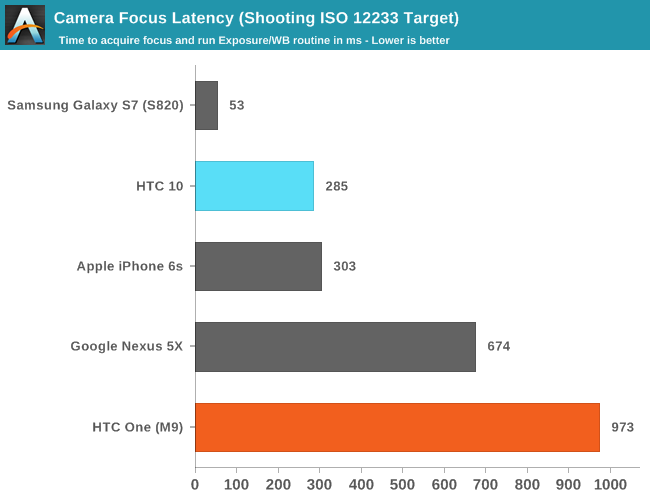
Looking at the focus test HTC has improved dramatically since the One M9 in daytime as the time of flight sensor allows for some estimation of where to focus before contrast detection does the fine adjustment. While it is faster than the iPhone 6s in daytime scenarios what should be noted here is that HTC’s contrast AF algorithm seems to be honestly rather poor in low light even with laser AF helping to guide the contrast AF search. The speed isn’t really the problem, but I’ve just seen it miss time and time again in low light scenarios and this is a major disadvantage relative to the Galaxy S7, iPhone 6s, and LG G5. While it’s probably no surprise that the Galaxy S7 is just better by miles due to the 12MP of phase detection pixels, the iPhone 6s and LG G5 shouldn’t be clearly superior to the HTC 10 here.
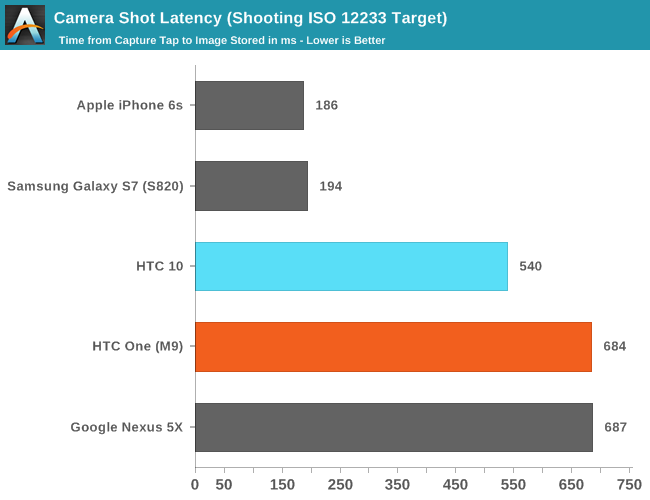
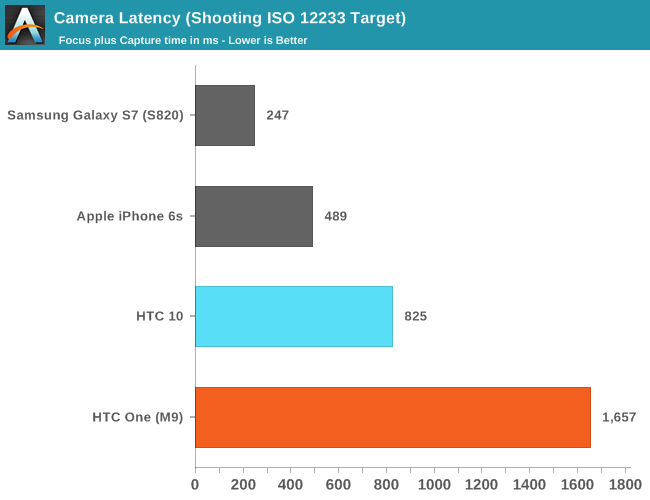
In capture latency the HTC 10 is appreciably faster than the One M9 to the extent that it feels about as fast as the One M8 but it’s still not really that quick. It might be appealing to point the blame at the eMMC used but the HTC 10 has highly variable capture latency even in daytime scenarios. While profiling will give the data that engineering needs to actually get to the bottom of this, I suspect that HDR processing is the bigger bottleneck here as capture latency tends to be significantly reduced if you disable HDR.
Overall, the HTC 10 has a decent base for a camera. It’s not going to win awards for innovation, but as OEMs converge on the “ideal” camera I’m not really sure that innovation really matters anymore so much as integration and execution. In that regard, HTC is doing the best that they’ve ever done, with a large sensor in both total area and pixel size, decent resolution, a clean and intuitive camera UI, and competitive camera latency. Relative to the competition, I would say that the Galaxy S7 is clearly better on the basis of dramatically lower latency, but relative to other devices the HTC 10 puts up a respectable showing. The only area that really needs attention by the next generation would be more reliable contrast AF in low light.


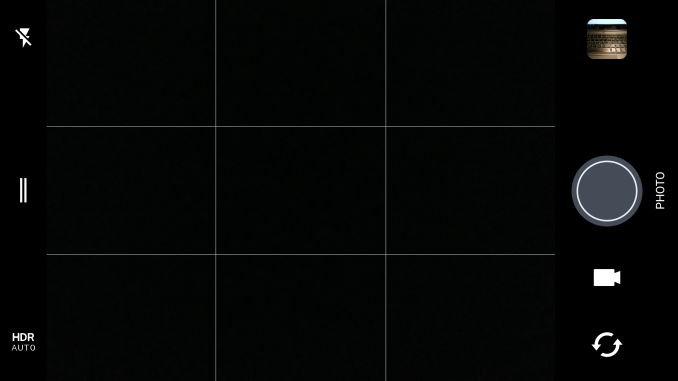
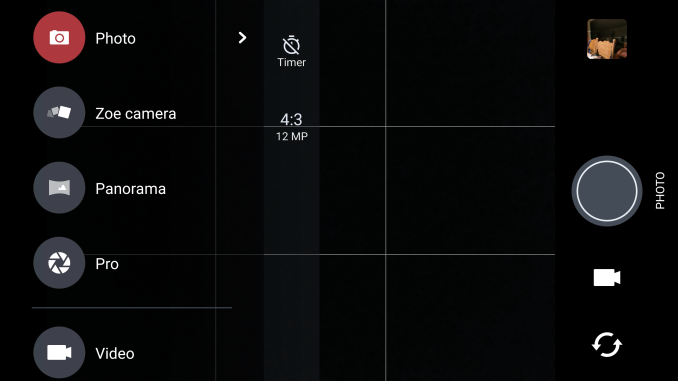
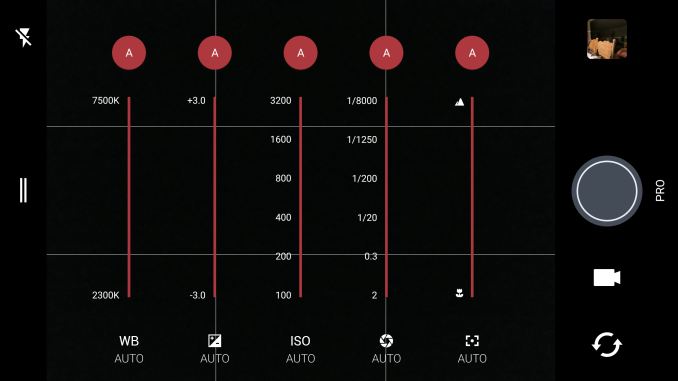
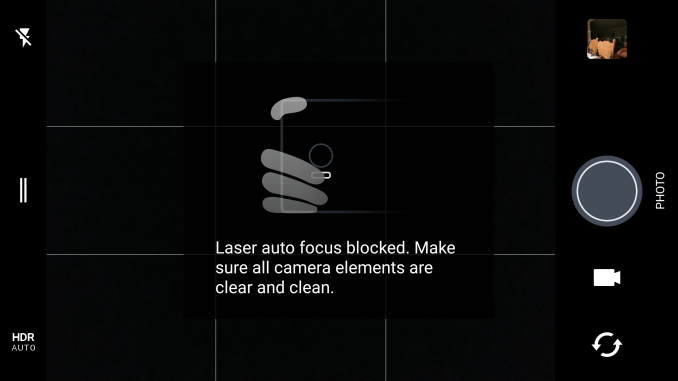








183 Comments
View All Comments
edlee - Wednesday, September 21, 2016 - link
i loved my m8, nothing i got recently feels as good as that phone did.Since that phone, i have had s6, and s7 edge, but for some reason m8 will always stick with me
bennyadamo - Thursday, October 6, 2016 - link
Agreed. The One M8 was a smartphone masterpiece. I owned both the M8 and a Galaxy S5 (and numerous iphones) and in terms of design, performance and user interface you still can't beat the M8. And HTC's Sense UI absolutely blows iOS and "Touchwiz" out of the water (just an aside, but how idiotic is "touchwiz" as a name for a UI? Or for anything else for that matter? I feel embarrassed just typing it). If you think the UI doesn't make a huge difference in your phone experience, try using Sense and Touchwiz side-by-side for a week. Even just small things like the small amount of lag time it takes for the display to re-orient from portrait to landscape when rotating the phone in your hand become infuriating when you have to live with Touchwiz daily. And besides the superior UI, the One M8 just looked and felt like a premium piece of hardware. Many, many times I had people ask me what type of phone it was or inspect it front to back when I let them hold it in their hands, impressed by the solid/premium feel of it. At this point, the One M8 is still (rather unfortunately) HTC's high-water mark. Although having said that I did just order the HTC 10 to take advantage of their sale ($150 off if you buy an unlocked phone directly from HTC from 10/1/16 to 10/8/16).Also, I read some of these comments saying that it's a waste of time to review or buy a phone 7 months after it's launch - that's not true and is a really misguided/misinformed opinion. A lot of people buy a phone that long after it's come out simply because they are waiting for their current phone contract to expire. Other reasons are because some of the teething bugs have been worked out or simply because the price drops after that amount of time (read above re: HTC's current sale on the HTC 10). The average person doesn't need to buy the newest/highest-end/highest-spec phone every year, and most people probably get 2-2.5 years out of a smartphone like this.
ipaulw83 - Monday, September 19, 2016 - link
certainly not dead, the HTC 10 is a far much better choice than the G5, S7 & Note 7 "Fiasco" and other flagships. the only real threat to HTC is the OnePlus 3 but overall the build quality and camera is in favor of HTC 10... i would hate to see them die or break software updates promises as recent news, nevertheless they have a great product that is more special than any other current android flagship (IMHO).i do not own any HTC product currently or stock or anything i use an iphone and an LG nexus 5x but wanted to give my opinion
repatch - Monday, September 19, 2016 - link
"far much better choice" for you perhaps. Why all the generalizing?I for one went with the LG G5, for one reason: the camera. The super wide angle camera on this thing is FANTASTIC, everyone who's seen it marvels at the kind of shots you get with it. It's REALLY fun. For ME, the "far much better choice" is the G5, but that won't apply to most others.
The S7 for me was a no go due to the glass back (can't stand glass backs because they are so prone to breakage, my Nexus 4 went through 3, and NONE of those were broken due to drops). The HTC 10 just didn't have anything 'special' going for it.
Again, that's MY opinion, it's best to sit down and write down what are go/no go's, for YOU, and make a choice that way.
IMHO of course.
Impulses - Thursday, September 22, 2016 - link
I really wanted to like LG's latest, I use an ultra wide lens on my mirrorless M4/3 cameras so that was right up my alley... The overall package (and uber gimmicky modules on their latest) never convinced me.If I HAD picked up a new phone last year it would've been a 10, for the better audio and lack of TouchWiz... My N5 is still trucking along tho, at least until the Pixels come out.
This breadth of choices, even in a market that's contacting, is still something I really like about the Android ecosystem.
FourEyedGeek - Monday, September 19, 2016 - link
Already have the Galaxy S7...smorebuds - Monday, September 19, 2016 - link
And this article is for you and only you...FourEyedGeek - Tuesday, September 20, 2016 - link
Its for all those people who want to make a decision on buying a new smartphone, but might have been helpful to those making a choice months ago don't you think?Freido - Monday, September 19, 2016 - link
HTC 10 is a nice looking phone. But it lacks a high brightness screen. It is a tad bigger as well. Thats my personal opinion. If it was a bit smaller like 4.9", I would have bought it. I've decided to buy Sony X compact or iPhone SE. Recent Sony phones like xlX performance and XZ sports very good displays I think. Looks as stunning as of iphones IPS displays.I was wondering why Anandtech never reviews Sony flagships even though they does release good phones with less gimmicks.
Will anyone consider my suggestion?
fanofanand - Monday, September 19, 2016 - link
They have addressed this in the past, typically Sony does not give out samples to the press. In today's "give me everything for free" world, websites like this simply don't have the excess cash to go buying every cool new toy that comes out. Would it be sweet? Absolutely, but for the most part if Anandtech doesn't review something it's because they couldn't obtain one from the company.